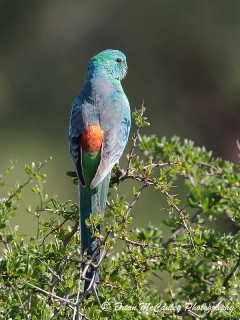Red-rumped Parrot |
|
|
Also known as: Red-rumped Parakeet, Red-backed Parrot or Parakeet, Redrump, Grass Parrot, Ground Parrot, Green Leek
Photos
View in GalleryDid You Know?
The Red-rumped Parrot feeds on seed heads by perching on the stem of a small plant until it gives way under its weight and bends to the ground, allowing the bird to pick off the seeds.Academic Research
Related publications: Psephotus haematonotusSpecies Profile
Genus: Psephotus | Species: haematonotus
Size:
27cm (10.5 in)
Weight:
55-85g (1.9-3 oz)
Subspecies including nominate:
two: P.h. haematonotus, P.h. caeruleus
Colour Adult:
P.h. haematonotus: Male-green head, upperparts and breast; yellow abdomen; white undertail coverts; red rump. Bill black. Eye brown/grey. Female-dull olive head, upperparts and breast; green rump and upper tail coverts; white undertail coverts variably suffused with pale blue. Bill dark grey. Eye grey.
P.h. caeruleus: Male-green paler in general plumage, more blue; orange/red rump. Female-brown/grey head and upperparts; white abdomen to undertail coverts.
Colour Juvenile:
P.h. haematonotus: In general duller than adults.
P.h. caeruleus: In general paler than juvenile haematonotus.
Call:
Calls are distinctive; contact calls are shrill and whistling notes with upward inflection. Also trilling, whistling notes while perched. Shrill chatter while bickering or defending nest area.
Listen NowVideo Links:
Video 1 | Video 2 | Video 3More Information:
Content Sources:
CITES
BirdLife International
Cornell Lab of Ornithology/Birds of the World
Parrots: A Guide to Parrots of the World, Juniper and Parr, 1998
Parrots of the World, Forshaw and Cooper, 1977. 2010 edition
Parrots of the World, Forshaw, 2006.
Lexicon of Parrots, Thomas Arndt.
Parrots in Aviculture, Low, 1992.
Photos
View in GalleryDid You Know?
The Red-rumped Parrot feeds on seed heads by perching on the stem of a small plant until it gives way under its weight and bends to the ground, allowing the bird to pick off the seeds.Academic Research
Related publications: Psephotus haematonotusSpecies Care
Captive Status:
Common
Longevity:
Not recorded.
Housing:
Walk-in enclosure, minimum length 2.1m (7 ft) or indoor aviary minimum length 1.8m (6 ft).
Diet:
Small seed mix such as: canary, millet and smaller amounts of oats, buckwheat, safflower and a little hemp; limited sunflower seed; spray millet; green leaves such as: Swiss chard, lettuce, sowthistle, dandelion, chickweed; seeding grasses; rearing food made from hard boiled egg, wholegrain and carrot, all ground to crumbly consistency; complete kibble.
Enrichment:
Vigorous chewers so provide bird-safe, unsprayed flowering, willow, fir, elder and pine branches; wooden block toys, heat sterilized pine cones, vegetable tanned leather toys; swings, ladders and ropes. Also enjoys bathing so provide overhead misters or shallow bowls of water.
Nest Box Size:
Vertical box 6" x 6" x 16" (15.2cm x 15.2cm x 40.6cm).
Clutch Size:
4-6
Incubation Time:
19 days
Fledging Age:
4-5 weeks
Hatch Weight:
Not recorded.
Peak Weight:
Not recorded.
Weaning Weight:
Not recorded.
Specialist Club:
Photos
View in GalleryDid You Know?
The Red-rumped Parrot feeds on seed heads by perching on the stem of a small plant until it gives way under its weight and bends to the ground, allowing the bird to pick off the seeds.Academic Research
Related publications: Psephotus haematonotusSpecies Wild Status
World Population:
Unknown, increasing.
IUCN Red List Status:
Least Concern
CITES Listing:
Appendix II
Threat Summary:
Not globally threatened. Common to abundant throughout range. Although at the start of the twentieth century it was in decline due to overgrazing and a disease outbreak, after the 1950s it had expanded its range east and west, apparently because of forest clearance and cereal cultivation creating new areas of suitable habitat.
Range:
P.h. haematonotus: SE Australia, from S Queensland to Victoria and E South Australia.
P.h. caeruleus: Lake Eyre basin and Cooper-Strzelecki Creeks drainages in SW Queensland, NW New South Wales and E South Australia.
Habitat:
Found up to 1000m (3280 ft) in open and riverine woodland, mangroves, grassland and farmland. Also seen in suburban areas, such as golf courses, roadsides and parks.
Wild Diet:
Diet includes seeds and leaves of grasses and herbaceous plants including Erodium botrys, Foeniculum, Boerhavia, Kochia, Linum, Echinochloa crusgalli, Onopordon acanthium, Synara cardunculus, Echium plantagineum, Papaver hybridum and Stellaria media. Feeds occasionally in eucalypts on seeds and flowers; also seen feeding on seed-capsules of Goodenia ovata, Schinus areira and fruits of Nitraria.
Ecology and Behaviour:
Resident with local movements after the breeding season. Seen in pairs or small flocks, as well as postbreeding groups of 100 or more. Feed on the ground and in trees and shrubs. Are active at dawn and dusk, resting during the heat of the day.
Clutch and Egg Size:
4-6 rounded eggs, 23.5 x 19.0mm (0.9 x 0.7 in).
Breeding Season:
August-January; nest is in hollow tree limb or trunk cavity.
Related Links:
Photos
View in GalleryDid You Know?
The Red-rumped Parrot feeds on seed heads by perching on the stem of a small plant until it gives way under its weight and bends to the ground, allowing the bird to pick off the seeds.Academic Research
Related publications: Psephotus haematonotusMembers Only Resources
Please log-in now to find more research, resources and tools.
Not a Member?
Find more great information:
Gain exclusive access to 600+ pages of additional research, seminars and podcasts, specialists to ask your toughest questions, and dozens of other fun resources - when you become a WPT member.
Join Today >>

































